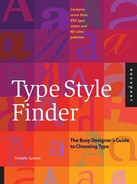
Type Style Finder
11
Combining Type Styles: The Basics
The conventional wisdom for mixing typefaces is to select two
type families for a given job. Context, however, plays an important
role in deciding whether or not to adhere to such a limitation.
The complexity of the information being presented affects the
decision to combine typefaces, as does the overall neutrality,
consistency, and expressiveness. If a job requires seven or eight
typefaces, so be it—but choose wisely.
Contrast among juxtaposed typefaces is critical. The only reason
to change a typeface is to gain an effect of contrast, so the
contrast achieved by the combination should be clearly recog-
nizable—otherwise, why bother? Opposing the extremes of
weight (light against bold), of width (regular against condensed
or expanded), or style (neutral sans serif against slab serif or
script), is a natural starting point. But somewhere in the mix,
even among extremes of this nature, there must be some formal
relationship between the selected fonts to enrich their visual
dialogue. Choosing a sans serif and a serif that are about the
same weight or width, for example, creates a tension of similarity
and difference that can be quite sophisticated. Selecting two
serif faces that are similar in weight, but very different in width
or contrast, achieves a similar tension. Sometimes this choice
is functional: for example, if the difference between the face
selected for text and its bold counterpart in the same family is
not particularly pronounced (meaning that the use of the bold
doesn’t achieve the desired emphasis), a similarly shaped bold
style may be substituted. Generally, it is unwise to combine
two faces of a similar style unless the difference is pronounced
enough for the average reader to notice.
The historical quality of typefaces may also play a role in how
they are selected and combined. Since the average reader usually
associates certain qualities with a given typeface because of its
classical or modern drawing qualities, mixing typefaces from
related—or dramatically different—periods may help generate
additional messages. A Roman capital, such as Trajan, in combi-
nation with a geometric sans serif, such as Futura, may not only
present a great deal of contrasting typographic color but may
also allude to a historical association: old and new, continuum,
evolution, innovation, and so on. In this particular case, both
Trajan and Futura are based on Roman geometric proportion,
despite being separated by 2,000 years of history.
The bold weight (A) of this text face isn’t much
different from the regular weight; therefore, a bold
face from an alternate yet similar family (B) may
be substituted. Note the similarity of the details
between the two faces.
When mixing typefaces, select counterparts with
enough contrast—but be aware of their potential
similarities as well. In this example, the serif (A)
and the sans serif (B) are radically different in
stroke contrast and detail, but their construction
is similarly geometric.
Nonlining numerals are more consistent with the
lowercase in running text; lining numerals are
stylistically simpler and therefore should be used
to set tabulated figures for greater clarity. When
mixing numerals from different typefaces, check
for similarities in their weight and width.
Combining a variety of type styles is a sure way
to increase the typographic color of a layout. Using
different widths, weights, and historical styles
together creates a poetic, expressive collage of
rhythm, light, and dark.
A
B
A
B
(Provision) Type Style Finder
CD606.006 / 4108
1 TSF_FM_001-015_new.qxd 6/3/06 10:25 AM Page 11
..................Content has been hidden....................
You can't read the all page of ebook, please click here login for view all page.
